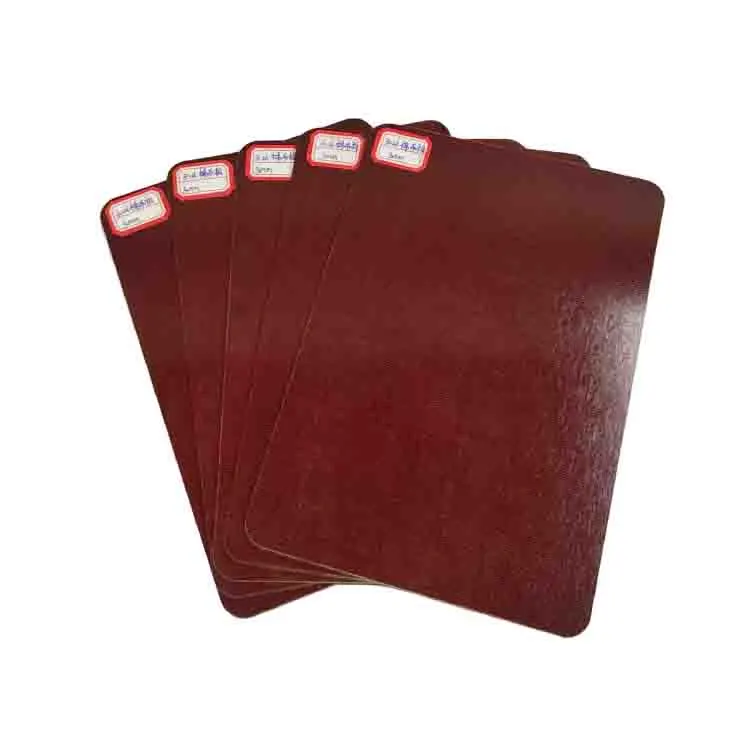Innovations Improving Phenolic Composite Performance
Nano-Reinforced Phenolic Composites
The incorporation of nanoparticles into phenolic resin matrices has led to remarkable improvements in composite performance. Nano-reinforced phenolic composites exhibit enhanced mechanical properties, including increased tensile strength and impact resistance. These nanoparticles, such as carbon nanotubes or graphene, create a more uniform distribution within the matrix, resulting in improved load transfer and better overall structural integrity. The nano-scale reinforcements also contribute to enhanced thermal stability and flame retardancy, making these composites ideal for high-temperature applications.
Advanced Curing Technologies
Innovative curing technologies have emerged to optimize the performance of phenolic resin sheets. Microwave curing, for instance, offers faster processing times and more uniform curing compared to traditional thermal methods. This technique results in composites with improved mechanical properties and reduced internal stresses. Additionally, UV-curable phenolic resins have been developed, enabling rapid curing at room temperature and reducing energy consumption during the manufacturing process. These advanced curing methods not only enhance the final product's quality but also contribute to more efficient and cost-effective production processes.
Hybrid Phenolic Composites
The development of hybrid phenolic composites has opened up new possibilities for tailoring material properties to specific applications. By combining phenolic resins with other polymers or reinforcing materials, manufacturers can create composites with unique combinations of properties. For example, phenolic-epoxy hybrids offer improved toughness and chemical resistance, while phenolic-ceramic hybrids provide exceptional heat resistance and dimensional stability. These hybrid composites allow for greater flexibility in design and enable the creation of materials that meet the complex requirements of modern industries.
Enhanced Thermal Resistance, Strength, and Sustainability
Advanced Thermal Management Solutions
Recent advancements in phenolic resin composites have led to significant improvements in thermal management capabilities. Researchers have developed phenolic resin sheets with enhanced thermal conductivity by incorporating thermally conductive fillers such as boron nitride or aluminum oxide. These materials effectively dissipate heat, making them invaluable in electronic applications where thermal management is crucial. Additionally, the development of ablative phenolic composites has revolutionized heat shield technology for aerospace applications, providing superior protection against extreme temperatures during atmospheric reentry.
High-Performance Fiber Reinforcements
The integration of advanced fiber reinforcements has dramatically enhanced the strength and durability of phenolic resin composites. Carbon fiber-reinforced phenolic composites offer exceptional strength-to-weight ratios, making them ideal for aerospace and automotive applications where weight reduction is critical. Similarly, aramid fiber-reinforced phenolic composites provide outstanding impact resistance and vibration damping properties. These high-performance fiber reinforcements enable the creation of phenolic resin sheets that can withstand extreme mechanical stresses while maintaining their dimensional stability and thermal resistance.
Sustainable Bio-Based Phenolic Resins
In response to growing environmental concerns, researchers have made significant strides in developing sustainable bio-based phenolic resins. These innovative materials utilize renewable resources such as lignin, tannins, or cardanol as partial or complete replacements for petroleum-based phenol. Bio-based phenolic resins offer comparable performance to their traditional counterparts while reducing the carbon footprint of composite materials. Furthermore, these sustainable alternatives often exhibit improved biodegradability and reduced toxicity, aligning with the increasing demand for environmentally friendly materials across industries.
Emerging Applications in Automotive, Aerospace, and Energy
Automotive Lightweighting Solutions
The automotive industry has embraced advanced phenolic resin composites as a key enabler of vehicle lightweighting strategies. These materials offer an excellent balance of strength, weight reduction, and cost-effectiveness, making them ideal for various automotive components. Phenolic composite body panels, interior trim, and under-hood components contribute to improved fuel efficiency and reduced emissions. Moreover, the inherent flame retardancy and low smoke emission properties of phenolic composites enhance vehicle safety, particularly in electric and hybrid vehicles where fire resistance is paramount.
Aerospace Structural Components
In the aerospace sector, technological advances in phenolic resin composites have led to their increased adoption in critical structural applications. High-performance phenolic resin sheet and phenolic composites are now used in aircraft interiors, including floor panels, overhead bins, and bulkheads, due to their exceptional fire resistance and low smoke toxicity. Additionally, phenolic prepregs have gained traction in primary and secondary aircraft structures, offering improved strength-to-weight ratios and excellent fatigue resistance. The development of radar-transparent phenolic composites has also opened up new possibilities for antenna radomes and electromagnetic windows in military and commercial aircraft.
Renewable Energy Infrastructure
The renewable energy sector has benefited greatly from advancements in phenolic resin composites. In wind energy applications, phenolic composites are used to manufacture lightweight and durable wind turbine blades, contributing to increased energy efficiency and reduced maintenance costs. Solar energy installations have also seen the implementation of phenolic composite mounting systems and protective enclosures, which offer excellent weather resistance and dimensional stability in harsh outdoor environments. Furthermore, the development of high-temperature phenolic composites has enabled their use in geothermal energy systems, where materials must withstand extreme heat and corrosive conditions.
Conclusion
The technological advances in phenolic resin composites have ushered in a new era of high-performance materials with diverse applications across industries. From nano-reinforced composites to bio-based alternatives, these innovations have significantly enhanced the thermal resistance, strength, and sustainability of phenolic resin sheets. As research continues to push the boundaries of what's possible, we can expect even more exciting developments in the field of phenolic composites, paving the way for more efficient, durable, and environmentally friendly solutions in automotive, aerospace, energy, and beyond.
Contact Us
To learn more about our cutting-edge phenolic resin sheets and how they can benefit your applications, please contact us at info@jhd-material.com. Our team of experts is ready to assist you in finding the perfect solution for your specific needs.






